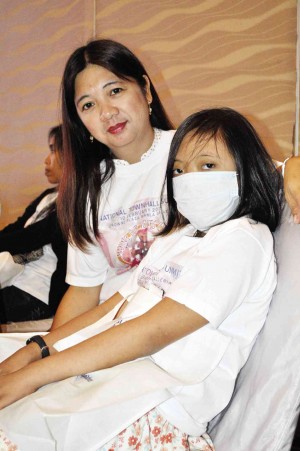
THANKS to PCMC and countless donors, mother Len Marie reports that Cheska’s three-year medication is almost finished and tests show that her daughter’s condition is improving
For almost three years this one room in the Philippine Children’s Medical Center (PCMC) in Quezon City has been home to 13-year-old Cheska Gozon and her mother Len Marie.
Cheska was born with Down Syndrome and when she was 10 years old, she was found to have acute lymphoblastic leukemia, an aggressive type of cancer in which Cheska’s bone marrow produces too many immature lymphocytes, a type of white blood cells.
Acute lymphoblastic leukemia is the most common type of cancer in children.
“When my daughter was newly diagnosed, we were here almost every day for check up as well as looking for someone or some ways that would enable us to pay for the medicines and diagnostic procedures needed,” related the 37-year-old Len Marie who had to discreetly sell “yema” (a type of custard candy) and macaroons in the hospital to augment the money that her husband Roger would earn from driving a tricycle in their hometown in Hagonoy, Bulacan.
Learning that Cheska also has cancer aside from suffering from a genetic disorder, was almost too much for Len Marie. “At first, I thought Cheska was just iron-deficient or anemic as she would just collapse on the floor, feeling too weak and looking pale. When she soon developed reddish and purplish dots on her belly and leg area, that was when I got scared and went to a doctor,” said Len Marie.
Her fears were soon confirmed when she was referred to PCMC, which since 1998 was designated by the Department of Health (DOH) as the national end-referral cancer center for children.
Thanks to PCMC’s Acute Lymphocytic Leukemia Medicines Assistance Program (Allmap), which provided free chemotherapy drugs to poor patients, Cheska was able to receive for three years free weekly chemotheraphy sessions, a regimen that would have cost the Gozon family about half a million pesos. Not yet included was the cost the family would have incurred for other required medicines such as antibiotics and antiemetic (treatment for nausea and vomiting as the result of taking chemotherapy drugs) as well as other needed diagnostic tests.
Cheska also benefited from the Z Benefit Package, which is offered to PhilHealth members to address health conditions, including Cheska’s illness, that require prolonged hospitalization and very expensive treatments. Len Marie said: “I would have considered this a miracle because aside from the free medicines we get, there are also many individuals—a lot of them anonymous—who would shoulder our other bills. At the moment, we are almost finished with the medication, and tests show that Cheska’s condition is improving.”
Acute lymphoblastic leukemia is among the most curable cancers in children if detected at the early stage, and treatment is continuous.
My Child Matters
The Allmap is a product of collaboration between PCMC and My Child Matters, a public mobilization campaign to improve access to care of Filipino childhood cancer patients. Recently, the PCMC, the lead implementor of MCM projects in the Philippines, was awarded by Sanofi Espoir Foundation with a new grant worth 70,000 euros (P3.5 million) to extend the ongoing childhood cancer projects under the global childhood cancer advocacy of the Union for International Cancer Control.
“The goal was to create public awareness about the curability of childhood cancer, particularly childhood leukemia, and implement community mobilization campaigns. It focused public attention to address delays in diagnosis and high treatment abandonment rates that were mainly responsible for poor survival rates of childhood cancer in the Philippines,” said Dr. Julius Lecciones, a leading paediatric oncologist and executive director of PCMC.
3,500 Filipino children
He related that about 3,500 Filipino children will develop cancer each year but only one-third will be diagnosed and treated in medical facilities. “Although multi-modal management is available and could potentially cure 80 percent of patients, less than 20 percent will attain long-term survival because two-thirds of the cases are diagnosed in advanced stages when cure is no longer possible, or can only be achieved using very aggressive and very expensive treatment available, which by the way is only available in large medical centers and which patients cannot afford,” said Lecciones.
Thanks to what PCMC and My Child Matters program has started in 2006, public awareness was increased:
- Late-stage of cancer diagnosis was decreased from 70 percent to 30 percent:
- Abandonment rate of treatment was reduced from 80 percent to 30 percent (a significant number of patients before were unable to continue follow-up visits due to financial constraints or because of their location from the nearest available medical center; and
- Survival rate was increased from 16 percent to 20 percent to 78 percent.
“We were just lucky that Hagonoy, despite the P400 bus ride is not too far from PCMC, that also has rooms that allow us to stay for the whole day as Cheska receives her medications,” said Len Marie who related that there were about a hundred children like Cheska staying at PCMC.
Lecciones, however, cautioned: “What we have achieved during the last 10 years are still fragile and can be lost if we do not involve the government. Largely through actions from civil society and individuals at the hospital level, we have demonstrated that we could achieve better outcomes in our patients with the modest investments made. Now is the time for all sectors of our society to unite and demand to put childhood cancer in the forefront of the government’s health agenda. This is the kind of action we now need to sustainably improved care for all Filipino children with cancer.”